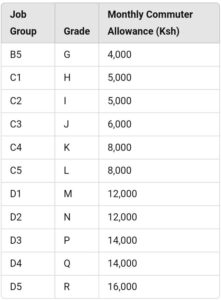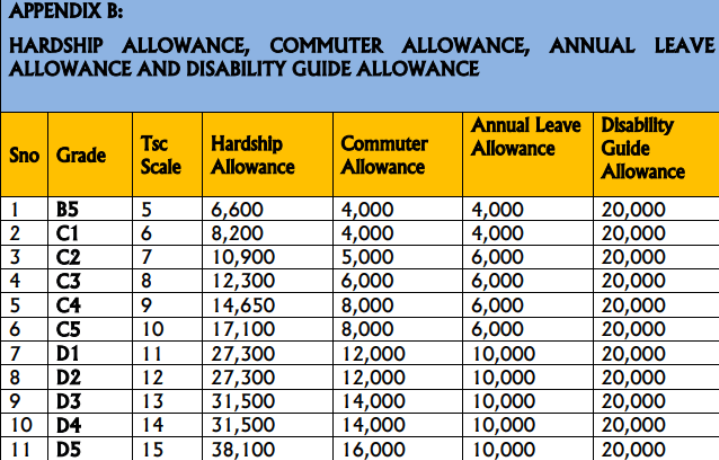In order to ensure that Kenyan educators receive fair compensation for their priceless services to the education sector, the Teachers Service Commission (TSC) is essential.
The commuter stipend, one of the many benefits offered to educators, is a crucial element intended to lessen the financial strain of everyday commuting.
For teachers in various work groups, the TSC has provided updated commuter allowance rates as part of the 2021–2025 Collective Bargaining Agreement (CBA).
TSC Teacher Commuter Allowance Rates by Job Group, 2025.
This article offers a thorough analysis of these rates, their importance, and how they demonstrate the TSC’s dedication to enhancing the welfare of teachers.
TSC Commuter Allowance Facts
The commuter allowance is a monthly benefit provided to teachers to cover transportation costs incurred while traveling to and from work.
This allowance is separate from the basic salary and is tailored to reflect the varying needs of teachers based on their job groups and TSC scales.
By addressing the commuting challenges faced by educators, the TSC aims to enhance their overall well-being and job satisfaction.
The 2021–2025 CBA has introduced updated commuter allowance rates, which are structured to ensure fairness and inclusivity across all job groups.
These rates are subject to periodic reviews, making it essential for teachers to stay informed about the latest updates from the TSC.
Updated Commuter Allowance Rates for 2025
The TSC has categorized teachers into different job groups, each with a corresponding commuter allowance rate. Below is a detailed breakdown of the updated rates for 2025:
Table 1: TSC Commuter Allowance Rates per Job Group

These rates are designed to reflect the varying responsibilities and commuting needs of teachers at different levels. For instance, senior administrators such as principals and chief principals receive higher allowances due to their extensive travel requirements.
Job Group Designations and Roles
To better understand the commuter allowance structure, it’s important to familiarize yourself with the job group designations and the corresponding roles:
– Grade B5 (T-Scale 5): Primary Teacher II
– Grade C1 (T-Scale 6) : Primary Teacher I, Secondary Teacher III, Lecturer III
– Grade C2 (T-Scale 7) : Secondary Teacher II, Lecturer II, Senior Teacher II
– Grade C3 (T-Scale 8) : Secondary Teacher I, Lecturer I, Senior Teacher I
– Grade C4 (T-Scale 9): Deputy Headteacher II, Senior Master IV, Senior Lecturer IV
– Grade C5 (T-Scale 10): Senior Master III, Headteacher, Deputy Headteacher I
– Grade D1 (T-Scale 11): Deputy Principal IV, Senior Master II, Senior Lecturer II
– Grade D2 (T-Scale 12): Deputy Principal III, Senior Master I, Senior Lecturer I
– Grade D3 (T-Scale 13): Principal
– Grade D4 (T-Scale 14): Senior Principal
– Grade D5 (T-Scale 15): Chief Principal
These designations highlight the progression of roles within the teaching profession, with higher grades reflecting increased responsibilities and leadership positions.
Significance of the Commuter Allowance
The commuter allowance is more than just a financial benefit; it is a testament to the TSC’s commitment to addressing the practical challenges faced by teachers. Here’s why this allowance matters:
1. Financial Relief: By covering transportation costs, the allowance reduces the financial strain on teachers, allowing them to focus on their duties without worrying about commuting expenses.
2. Improved Morale: Teachers who feel supported in their daily lives are more likely to be motivated and productive in their roles.
3. Equity and Fairness: The tiered structure ensures that teachers at all levels receive fair compensation based on their roles and responsibilities.
4. Retention and Recruitment: Competitive allowances make the teaching profession more attractive, helping to retain experienced educators and attract new talent.
Staying Updated on TSC Guidelines
While the commuter allowance rates for 2025 have been outlined, it’s important to note that these figures are subject to change. The TSC periodically reviews its policies to align with economic conditions and the evolving needs of teachers. Educators are encouraged to:
– Regularly check official TSC circulars and announcements.
– Consult with their school administrators or union representatives for the latest updates.
– Stay informed about any changes to the CBA or other relevant policies.
Conclusion
The TSC commuter allowance rates for 2025 reflect a thoughtful approach to supporting teachers’ financial well-being. By addressing the practical challenges of commuting, the TSC demonstrates its commitment to creating a conducive working environment for educators.
As the teaching profession continues to evolve, it is crucial for teachers to stay informed about their benefits and advocate for policies that enhance their welfare.
The updated commuter allowance rates, coupled with other benefits under the 2021–2025 CBA, underscore the TSC’s dedication to recognizing and rewarding the hard work of Kenya’s educators.
By prioritizing teachers’ needs, the TSC is not only improving individual lives but also strengthening the foundation of the country’s education system.
